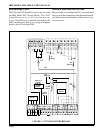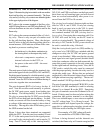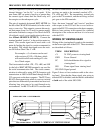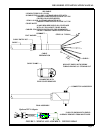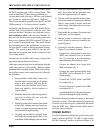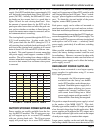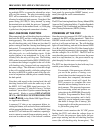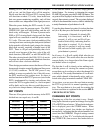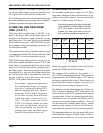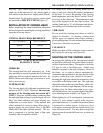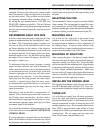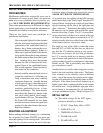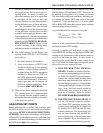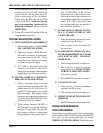
IRIS MODEL P522 APPLICATION MANUAL
Page 11
blinking, SELF-CHECK O.K. light on the front panel
will go out, and the flame relay will de-energize.
Please note that the S509 and S512 viewing heads
will shut down at about 17.0 volts; these heads have
their own power-monitoring capability, and will shut
down on their own, independent of the signal processor.
When the power feeding the P522 exceeds 19 volts,
the processor starts the program again. The SELF-
CHECK O.K. light will start blinking, and the self-
check relay will energize. If flame is present and a
S509 or S512 viewing head is being used, the flame
signal will not come back on until the power reaches
21.5 volts. This can cause a lockout condition if the
viewing head turns on during the dark period (defined
by the periodic self-check signal going to the viewing
head each second), requiring a manual reset of the
P522. There is a 20 per cent probability that a lock-
out will occur because of the duty cycle of the self-
check function (200 mSEC on and 800 mSEC off).
The other viewing heads (the S506, S511) do not in-
corporate the power-monitoring shutdown function,
and will not cause a lockout condition.
These design precautions ensure that there will never
be an unsafe situation created by abnormal line power
(115 VAC) conditions. The 26 VDC power is very
unlikely to come on gradually, but, if this did occur,
the P522 would not get a proper reset. So, there is
another function in the 87C52 processor (used in the
P522), implemented by circuitry and software, that
causes the P522 to appear dead (i.e., the front panel
will be dark) and to stay this way until the power is
recycled in an abrupt manner, initiating the reset.
SET POINTS
There are 10 set points stored in memory in the P522,
divided into two equal sets, A and B.
To see what the current set points are, simply push the
desired button. For instance, to determine the current
FLAME ON set point, press the FLAME ON button. The
set point will be displayed on the readout for about four
seconds, then return to normal. The set points displayed
will be for the channel that is active, which is indicated by
a steady illumination of push-button A or B.
To see the other channel set points, first select the chan-
nel (A or B), then press the desired set point button.
For example: if channel A is already ON,
indicating it is functional, and B is
pressed, A will go out and B will pro-
ceed to blink slowly, indicating that fur-
ther action is required. If A is already
ON and A is pressed, it will stay steady
ON and start to blink rapidly after a set
point button is pressed.
In all cases, A or B will rapidly blink after the set
point is selected. This action alerts the user that the
current display is no longer that of the flame signal,
and further action is required.
The fact that A or B is already on has nothing to do
with the process of viewing the current set points,
except that you do not have to select the channel if it
is already on. The steady illumination of A or B indi-
cates which channel is functionally active, and is se-
lected at the plug-in terminals marked CHAN SEL.
At any time, you can press the reset button causing
the P522 to go back to its normal operating condi-
tion. The reset button is also used for resetting the
lockout condition as explained in the section SELF-
CHECKING FUNCTION.
CHANGING SET POINTS
Changing any of the five set points is easy. Simply
bring up the desired set point and change it using the
UP or DOWN arrow buttons. When the desired num-
ber is displayed, press the STORE button. When
the set point is stored, four dashes are displayed
momentarily, indicating that the selected number was
stored into the EEPROM. Illogical settings cannot
be made; so, if four “E’s” are displayed when push-
ing STORE P.B., then an error was made when se-
SET POINT DISPLAY NUMBER
FLAME ON 4 DIGIT NUMBER 0001-2999
FLAME OFF 4 DIGIT NUMBER 0000-2999
GAIN SET 2 DIGIT NUMBER 00-99
F.F.R.T. 1 DIGIT NUMBER 1, 2 OR 3
TIME DELAY ON 1 DIGIT NUMBER 0, 1, 2 or 3
FIGURE 5 - SET POINTS




